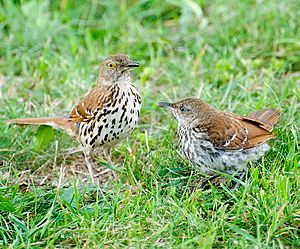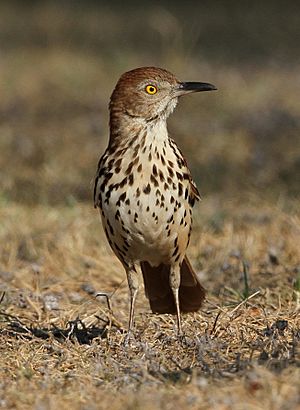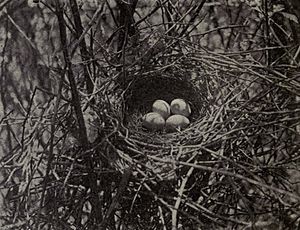Brown thrasher facts for kids
Quick facts for kids Brown thrasher |
|
|---|---|
 |
|
| Adult in New York, U.S. | |
| Conservation status | |
| Scientific classification | |
| Genus: |
Toxostoma
|
| Species: |
rufum
|
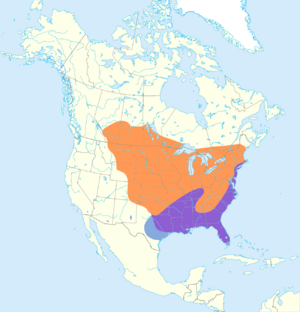 |
|
| Range of T. rufum Breeding range Year-round range Wintering range | |
| Synonyms | |
|
|
The brown thrasher (Toxostoma rufum) is a fascinating bird from the Mimidae family. This family also includes catbirds and mockingbirds, known for their amazing songs. You can find brown thrashers all over the eastern and central United States and southern and central Canada. It's special because it's the only thrasher bird that mainly lives east of the Rocky Mountains. This bird is so loved that it's the official state bird of Georgia!
Brown thrashers are quite large for their group. They have a reddish-brown back and a white belly with dark stripes. Sometimes people confuse them with the smaller wood thrush. One of the most incredible things about the brown thrasher is its song. It can sing over 1,000 different types of songs, which is more than almost any other bird! Each part of its song is usually repeated two or three times.
This bird eats many different things, from insects to fruits and nuts. They usually build their nests in bushes, small trees, or sometimes even on the ground. Brown thrashers are often shy, but they are very protective of their nests. They will even try to scare away large animals, including humans, if they feel their home is in danger.
Contents
Meet the Brown Thrasher!
What's in a Name?
The brown thrasher was first described by a famous scientist named Carl Linnaeus way back in 1758. He called it Turdus rufus. The genus name Toxostoma comes from ancient Greek words meaning "bow" or "arch" and "mouth," referring to its curved beak. The specific name rufum is Latin for "red," describing its reddish-brown color.
Even though it's not a true thrush, some people mistakenly call it the "brown thrush." The name "thrasher" might come from the sound it makes when it digs through leaves on the ground, or when it smashes insects to eat them. Scientists have studied the brown thrasher's family tree and found it's closely related to the long-billed and Cozumel thrashers.
How to Spot a Brown Thrasher
The brown thrasher has a beautiful reddish-brown color on its back. Its belly is a lighter, buffy color with thin, dark streaks that look like teardrops. It has a long, rounded, reddish-brown tail with lighter corners. Its eyes are a bright yellow, and its beak is long, brownish, and curves downwards. Both male and female brown thrashers look very similar. Young thrashers look a lot like adults, but their feathers might be a bit softer, and their eyes can be olive-colored.
Brown thrashers are medium-sized songbirds. They are about 23.5 to 30.5 centimeters (9 to 12 inches) long. Their wingspan is about 29 to 33 centimeters (11 to 13 inches). They usually weigh between 61 and 89 grams (2.1 to 3.1 ounces). There are two main types, or subspecies, of brown thrashers. One lives in the eastern parts of Canada and the U.S., and the other, called the 'western brown thrasher,' lives in the central U.S. and southern Canada. The western type has a slightly more cinnamon color on its back and darker spots on its chest.
Brown thrashers can live for several years. The oldest known thrasher in the wild lived to be 12 years old! Things like sickness and very cold weather can affect how long they live.
Similar Birds
The similar-looking long-billed thrasher has a significantly smaller range. It has a gray head and neck, and has a longer bill than the brown thrasher. The brown thrasher's appearance is also strikingly similar to the wood thrush, the bird that it is usually mistaken for. However, the wood thrush has dark rounded spots on its under parts rather than the brown thrashers' elongated streaks. It also has dark eyes, a shorter tail, a shorter, straighter bill, and is a smaller bird.
Where They Live and Travel
Brown thrashers live in many different places. They especially like the edges of woodlands, thick bushes, and dense shrubs. They often look for food among dry leaves on the ground. You might also find them in farm areas or near towns, but they usually prefer places with more cover.
Many brown thrashers migrate, meaning they travel to warmer places for winter. However, some thrashers in the southern parts of their range stay put all year. They breed across the eastern U.S. and Canada. Over the last century, as more trees grew in the Great Plains, brown thrashers have even expanded their range further west. Birds from New England might fly to the Carolinas and Georgia for winter. Those from the central U.S. and Canada often head to eastern Texas and Louisiana. When they migrate, they usually travel short distances at night.
Brown Thrasher Behavior
Brown thrashers are usually seen alone or in pairs. They are often shy and fly close to the ground to stay hidden. If they feel threatened, they will quickly hide in thick bushes and make cackling sounds. They spend most of their time on or near the ground. When you do see them out in the open, it's often the males singing from a high branch.
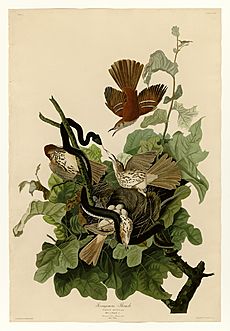
These birds are known for being protective, especially around their nests. They will bravely defend their home! The name "thrasher" doesn't come from attacking threats, but from the way they "thrash" or toss leaves aside when looking for food. It might also come from the way they thrash large insects to break them apart before eating.
What They Eat
Brown thrashers are omnivores, meaning they eat both plants and animals. Their diet includes many insects like beetles and grasshoppers. They also enjoy berries, nuts, seeds, earthworms, and snails. Sometimes, they even eat small lizards or frogs! During the warmer breeding season, they eat more insects. As summer ends, they switch to eating more fruits, nuts, and seeds. In winter, fruits and acorns become a big part of their diet.
Brown thrashers use their excellent eyesight to find food. They search under leaves, bushes, and dirt on the ground. They use their strong beaks to sweep the ground from side to side, looking for hidden treats. They can even crack open tough nuts like acorns by hammering them. Scientists have observed a thrasher digging a small hole, placing an acorn in it, and then hitting it until it cracked open – a clever way to use a "tool"!
Raising a Family (Reproduction)
Brown thrashers usually stay with one mate for a breeding season. Their breeding time changes depending on where they live. In the southeastern U.S., they start breeding in February or March. In northern areas, it begins in May or June. When males arrive at the breeding grounds, they sing loudly from high perches to attract a mate.
The male and female will exchange small gifts like twigs or leaves as part of their courtship. Both parents work together to build the nest. Nests are usually made of twigs and lined with grass and leaves. They are often built in dense bushes or low trees, usually up to 2.1 meters (7 feet) high, but sometimes higher. They might also build nests on the ground.
The female lays 3 to 5 eggs. These eggs are usually bluish or greenish with reddish-brown spots, though sometimes they have no spots. Both parents take turns sitting on the eggs to keep them warm, but the female does most of it. After about 11 to 14 days, the eggs hatch. The parents then feed the young birds. The baby thrashers leave the nest (fledge) when they are 9 to 13 days old. Brown thrashers can raise two, or sometimes even three, groups of babies in one year. The male is very protective and will bravely defend the nest from anything that comes too close.
Their Amazing Songs
The male brown thrasher is a true superstar singer! It has the largest song collection of any North American bird, with over 1,100 different songs documented. Some experts even say they can have up to 3,000 unique song phrases! Their songs are melodic and often repeat phrases two or three times, sometimes for minutes on end. In the fall, their songs become softer. During winter, males might sing short bursts when they have disagreements with other males.
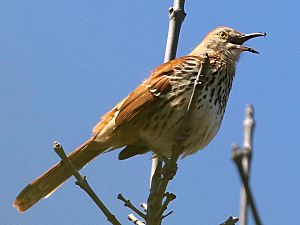
Young thrashers mostly make alarm noises. As adults, they have many different calls for various situations. Both males and females make "smack" and "teeooo" alarm calls when they feel threatened. They also make "hijjj" sounds at dawn and dusk. Other calls include a sharp "chakk," a rolling "rrrrr," or sounds like a stick scraping concrete. Brown thrashers are also good at mimicking other birds, though not as much as their cousin, the northern mockingbird. During breeding season, the male's mimicry is at its best, copying sounds from birds like tufted titmice, northern cardinals, and wood thrushes.
Facing Challenges
Even though brown thrashers are common, their numbers have decreased in some areas. This is mainly because they are losing their natural homes. However, their population is still strong enough that they are not considered an endangered species.
One challenge they face is from brown-headed cowbirds. Cowbirds sometimes lay their eggs in thrasher nests, hoping the thrashers will raise their young. But brown thrashers are smart! They usually recognize the cowbird eggs and push them out of the nest. Sometimes, they might accidentally push out one of their own eggs if it looks similar. Other birds like northern cardinals and grey catbirds can also compete with thrashers for nesting spots. Predators like snakes, birds of prey (like hawks and owls), and cats are also threats to brown thrashers and their nests.
To defend themselves, brown thrashers use their strong beaks, which can hurt smaller animals. They also flap their wings and make loud calls to scare away danger.
Georgia's State Bird
The brown thrasher is the official state bird of Georgia. It was also the inspiration for the name of Atlanta's former professional hockey team, the Atlanta Thrashers. That team moved in 2011 and became the Winnipeg Jets.
See also
 In Spanish: Cuitlacoche rojizo para niños
In Spanish: Cuitlacoche rojizo para niños



